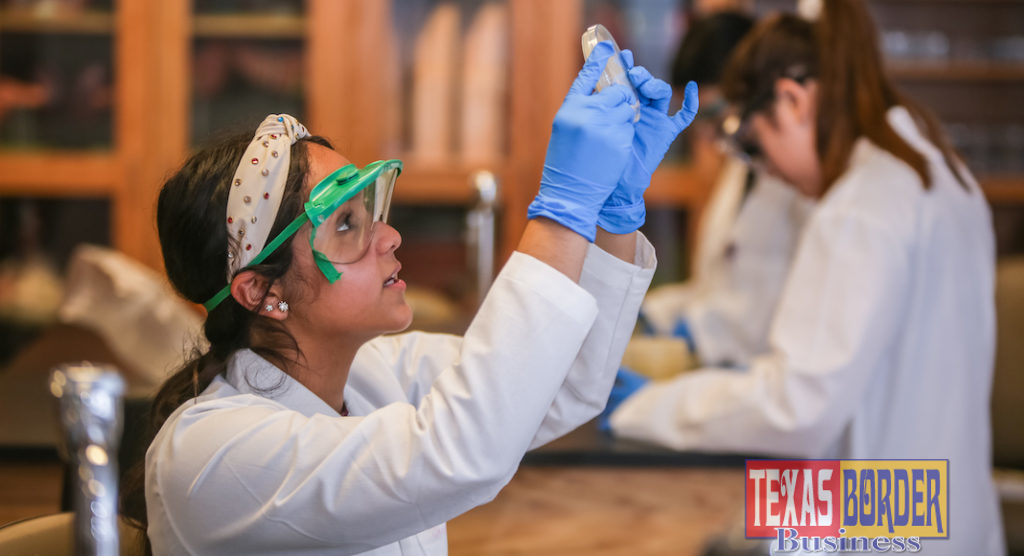
Texas Border Business
McAllen, TEXAS – At 16, Daniela De la Garza is harvesting soil samples from her Sharyland backyard for a South Texas College research project, and there’s a small chance that what she finds could leave to a groundbreaking discovery.
De la Garza is one of 19 Dual Enrollment students in the Medical Science Academy at STC that is hunting for new viruses in her very own community as part of the prestigious program, SEA-PHAGES — Science Education Alliance-Phage Hunters Advancing Genomics and Evolutionary Science. If a unique virus is found, it could ultimately be used as an alternative to antibiotics.
SEA-PHAGES is a nationwide collaboration in which undergraduates from 177 institutions search for new bacteriophages, which are viruses that eat bacterial cells.
The Howard Hughes Medical Institute established SEA-PHAGES to encourage interest in biological sciences by providing undergraduates with valuable research opportunities. The institute runs the program with the University of Pittsburgh.
STC is the first institution in the Rio Grande Valley to join SEA-PHAGES, says Dr. Maria Y. Cervantes, chair of STC’s Biology Department. The program is a great way to get students involved in research and promote STEM fields.
“We’re very unique especially because we are a border town, so the expectation is that we probably do have bacteriophages that are very unique to the area,” Dr. Cervantes says.
The College’s participation is also significant because there are few laboratory research projects at community colleges. Most of the students in the SEA-PHAGES course at STC are high school juniors and seniors.
“I just thought it was really interesting that we could have the chance to find something ourselves,” says De la Garza, who is in the first group of students to take the course at STC. “It’s one thing to hear about discoveries but it’s another thing to be going through it myself.”
The course is designed as an introductory lab course for students, Dr. Cervantes says. The SEA-PHAGES program has found that students who take part in this authentic lab experience are more likely to continue studying the sciences than those who take traditional biology lab courses.
De la Garza has always had dreams of working in the healthcare field. “I’ve always wanted to do something medical,” she says. “I’ve always just wanted to help people.”
“The students are going to experience something that is new, something that has not been done here before, with an opportunity to open doors to a life of science,” Dr. Cervantes says.
For those who want to go to medical school, it shows them how science goes hand in hand with that career, she explains. The tools and methods physicians use to treat patients all started in a lab.
“So exposing the students to that very first step in medicine, which is learning how organisms work, how drugs work, is going to hopefully give them a better appreciation for when they become doctors and move onto something bigger and better,” Dr. Cervantes says. “And hopefully the students will be encouraged to not just pursue their Associate, but their Bachelor’s and then a higher-level degree – graduate school, medical school, and the sky’s the limit for them.”
The students’ research so far has exceeded expectations, Dr. Cervantes says. “They told us if you get three students to purify a virus out of a 20, you are doing great. You know what these students did? Fourteen out of the 19 have successfully purified a virus,” she says.
The prevalence of antibiotic-resistant bacteria makes this area of study particularly important and timely, Dr. Cervantes says. There are so many viruses being found that the possibility the students have discovered new ones is very high, she says.
Recently, a virus identified by university students in the SEA-PHAGES program helped cure an England girl’s antibiotic-resistant respiratory infection, Dr. Cervantes says. The girl received an injection of a cocktail of three viruses that specifically fought this bacteria.
The potential for STC students to make an impact in microbiology is “phenomenal,” says STC President Shirley A. Reed, who visited the lab to learn about their work. “Just think if we actually could identify a selected virus that would eat bacteria. We wouldn’t be using prescription drugs to kill bacteria,” Dr. Reed says. “And I understand viruses are rather smart critters; they evolve and change. Maybe they can be trained to go after cancer cells.”
Most of the students took soil samples from near their homes during their research. They will find out next semester if their viruses are unique. If so, they will be able to name them and submit them to the depository.
“We’ve got very interesting results,” says Dr. Thomas Ndolo, who teaches the course, adding that the phages students are collecting look very different.
The students are engaged in the research, he says. They are meticulous and some are spending extra time in the laboratory. It took 10 weeks for them to develop their phages.
Students in the class who did not find any phages have teamed up with others who have, says De la Garza. They are preparing to send their samples to the University of North Texas, which will use electron microscopes to visualize the viruses and send back photos.
In the spring semester, the STC students will perform DNA sequencing and analyze the genomes through bioinformatics. They will compare their phages to those that are already in the repository to see if they have something unique.
“We’ll be having them use a lot of computer programs, where they’ll be putting in their DNA sequence and comparing it to different databases, sort of like forensic science, but in this case we’re trying to identify the virus and see if it’s something that is worth publishing and looking into,” Dr. Cervantes says.
The students are also getting valuable experience in the long and labor-intensive research process, and the highs and lows that accompany it. “It’s on your way of getting to your destination that you’re learning, that you’re going through trials, that you’re feeling heartbroken and then excited,” Dr. Cervantes says.
They will also have the satisfaction of contributing to an extensive body of knowledge that expands with each addition to the Howard Hughes Medical Institute’s national library of phages, she says.
“South Texas College encourages the pursuit of the sciences to ensure that our students are prepared for high-demand, high-skilled workforce and academic opportunities in healthcare, research, and related fields,” said Mr. Paul R. Rodriguez, Chairman of the Board.
“The highly competitive Howard Hughes Medical Institute’s (HHMI) SEA-PHAGES Program recognizes the quality of our students, faculty, and facilities. This is an incredible opportunity to take part in cutting edge research addressing critical issues, and we could not be more proud of our students’ exceptional successes and contributions to this prestigious program.”












